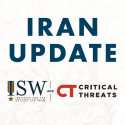Iran Update, June 3, 2025
Jun 3, 2025 - ISW Press
Iranian Foreign Affairs Minister Abbas Araghchi likely discussed the Lebanese government’s efforts to prevent Hezbollah’s reconstitution during a visit to Beirut on June 3.

Iranian Foreign Affairs Minister Abbas Araghchi likely discussed the Lebanese government’s efforts to prevent Hezbollah’s reconstitution during a visit to Beirut on June 3.

Iran and the United States appear to be trying to secure an interim nuclear deal before negotiating a comprehensive nuclear agreement. It is unclear if the reported interim deal that Iran seeks will satisfy US demands. Iran may be portraying itself as willing to make concessions in order to prevent the talks from collapsing and potentially triggering an Israeli strike on Iranian nuclear facilities.

A visit to southeastern Iran by a senior Iranian officer illustrates Tehran’s security concerns over anti-regime militancy in southeastern Iran.

Iran continued to threaten US bases and forces, likely to try to discourage a potential US or Israeli strike on Iranian nuclear facilities amid US threats to strike these facilities.

The United States has asked the Syrian interim government to curtail foreign fighters’ influence in the Syrian government in exchange for partial sanctions relief, according to Reuters.

The Houthis have sought to obtain hydrogen fuel cells from unspecified Chinese suppliers to increase the range and payloads of their drones, according to a November 2024 Conflict Armament Research (CAR) investigation.

Current Syrian interim government counterinsurgency operations are insufficient to defeat pro-Assad insurgent cells across Syria.

US sanctions on Houthi officials for coordinating with Russia demonstrate how Russia facilitates Iranian-backed groups’ terrorism in the Middle East. The United States designated the Houthis a foreign terrorist organization and sanctioned eight Houthi officials for facilitating attacks on international shipping and for recruiting Yemenis to fight for Russia in Ukraine.

The Syrian Preparatory Committee does not plan to include the Kurdish-majority Syrian Democratic Forces (SDF) or its political wing, the Democratic Union Party (PYD), in the National Dialogue Conference.

Unspecified sources told Bloomberg that Russia appears to be nearing a deal with the Syrian interim government to maintain a “reduced” military presence in Syria